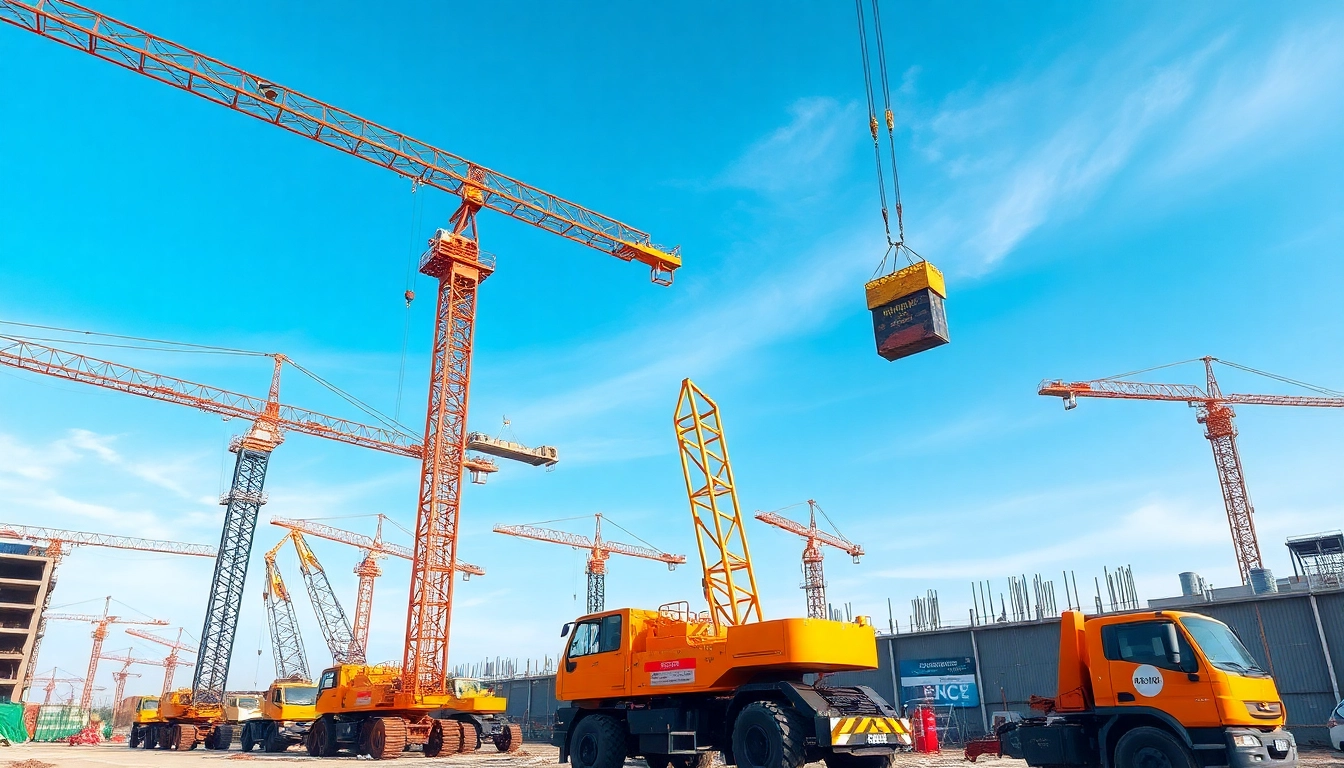
Understanding Crane Rental Options and Their Applications
Crane rental has become an essential component in the modern construction and industrial sectors across the UK. Whether it’s a small-scale renovation or a large infrastructure project, renting a crane offers flexibility, cost-efficiency, and access to specialized lifting solutions that might otherwise be impractical to own outright. As the demand for efficient lifting equipment grows, understanding the various types of cranes, their uses, and how to select the best rental options is crucial for project managers, contractors, and business owners alike. For those embarking on construction ventures or industrial lifts, exploring crane rental options can dramatically influence project timelines, safety standards, and overall budget management.
Different Types of Cranes and Their Uses in Construction
There exists a broad spectrum of cranes tailored to meet diverse lifting requirements in construction and industrial environments. Each type offers distinct advantages, operational scopes, and cost profiles. Selecting the right crane type hinges on project specifics such as load capacity, site conditions, and logistical constraints. Below is an in-depth overview of the most commonly rented cranes:
Mobile Cranes
Mobile cranes are versatile, providing rapid setup and mobility across various site conditions. They are preferred for their flexibility and are available as truck-mounted or wheeled cranes. Mobile cranes excel in tasks like heavy lifting on uneven terrains, quick repositioning between different parts of a project, and smaller to medium-sized lifts.
Tower Cranes
Tower cranes are iconic in high-rise construction. These cranes are erected on-site and provide height and reach capabilities unmatched by other types. They efficiently handle heavy loads at great heights, making them indispensable for skyscraper projects. Modern tower cranes often come with self-erecting features, simplifying installation and dismantling.
All-Terrain Cranes
Combining the features of truck cranes and rough-terrain cranes, all-terrain cranes are designed for off-road and urban environments, where adaptability is key. They are ideal for projects requiring both mobility and high lifting capacities across varied terrains.
Crawler Cranes
Equipped with tracks instead of wheels, crawler cranes offer superior stability and lifting capacity, particularly suited for heavy industrial projects or where ground conditions are poor. They are often used in heavy civil engineering, dam construction, or port activities.
Mini, Spider, and Portable Cranes
For smaller projects, indoor lifting, or confined spaces, mini and spider cranes provide exceptional maneuverability. These compact cranes can operate within restricted spaces where larger cranes cannot fit, ideal for manufacturing plants, renovations, or small-scale industrial work.
Choosing the Right Crane Rental for Your Project Size and Scope
Selecting an appropriate crane rental begins with careful evaluation of project parameters. Factors such as load weight, reach height, site conditions, and duration all influence the optimal crane type. Here are essential considerations:
- Load Capacity: Accurately estimate the maximum weight to be lifted, including additional safety margins. Overestimating can lead to unnecessary costs, while underestimating risks safety and equipment integrity.
- Height and Reach: Determine the maximum height and horizontal reach required. For high-rise buildings, tower cranes or luffing jib cranes may be necessary, while for ground-level lifting, mobile cranes suffice.
- Site Constraints: Evaluate space limitations, accessibility, and ground stability. Compact sites might need mini or spider cranes, whereas open areas accommodate larger equipment.
- Duration of Hire: Short-term projects often benefit from daily or weekly rentals, while longer projects might negotiate more favorable terms. Price comparisons should include delivery, setup, and operational costs.
Engaging with experienced rental providers ensures a tailored solution that aligns with your project’s specific demands and budget constraints.
Benefits of Hiring Over Buying Equipment
Opting to rent cranes instead of purchasing offers several strategic advantages, especially for companies with fluctuating project pipelines or limited capital. Here are the key benefits:
- Cost-Effectiveness: Avoid large capital expenditure and ongoing maintenance costs. Rentals often include technical support and maintenance in the price, reducing hidden expenses.
- Access to Latest Technology: Rental companies frequently update their fleet with modern, safer, and more efficient cranes, providing tenants with cutting-edge equipment.
- Flexibility: Renting allows for scaling equipment usage based on project needs. You can opt for different crane types or capacities without the long-term commitment of ownership.
- Reduced Storage and Maintenance Burden: Equipment remains the rental provider’s responsibility, freeing your organization from storage logistics and maintenance liabilities.
- Safety and Compliance: Rental companies comply with current safety standards and certifications, ensuring your project adheres to legal and safety regulations, reducing liability risks.
In fast-paced construction environments, rental solutions foster agility and operational efficiency, making them an attractive option for most project types.
Factors to Consider When Selecting a Crane Rental Provider
Service Area and Availability Across the UK
Comprehensive coverage and quick availability are fundamental to the success of any crane rental arrangement. Providers with extensive regional networks can respond swiftly to urgent demands, minimizing downtime. When evaluating potential suppliers, confirm their service coverage areas, especially if your project spans multiple locations or regions. Local providers often offer quicker setup times, on-the-spot support, and familiarity with regional regulations.
Fleet Capacity and Equipment Range
A diverse and modern fleet enables a rental company to provide tailored solutions for each project. Check the provider’s range of cranes, ensuring they possess equipment that matches your needs — from small mini-cranes to large tower or all-terrain models. The availability of various lifting capacities and features ensures flexibility and reduces project delays caused by equipment mismatches.
Safety Standards and Certification Compliance
Safety is non-negotiable in crane operations. Ensuring your rental partner complies with UK health and safety standards, such as LOLER (Lifting Operations and Lifting Equipment Regulations), is vital. Reputable providers should furnish documentation, routine inspections, maintenance logs, and operator certifications demonstrating their commitment to safe practices. Investing in certified equipment and qualified operators significantly minimizes accident risks and legal liabilities.
Cost Insights and Budgeting for Crane Rentals
Average Rental Prices in the UK Market
Understanding typical costs helps in accurate budget planning. According to recent data, the average daily rental price for a 25-tonne crane in the UK hovers around £650, while weekly rates for similar capacities average about £3,000. Larger cranes or specialized equipment like tower or all-terrain cranes command higher premiums, often ranging from £1,000 to over £2,500 per day depending on capacity and features. It’s advisable to obtain quotations from multiple providers for the most competitive rates.
Additional Costs: Delivery, Installation, and Operator Fees
The base rental price typically covers only the equipment. Additional charges often include:
- Delivery and Pickup: Costs depend on distance and accessibility but generally range from £100 to several hundred pounds.
- Installation and Setup: Professional setup ensures safety and operational readiness, with fees varying based on complexity.
- Operator Fees: If your project lacks qualified operators, rental companies often provide certified operators at daily rates, usually between £200-£400.
- Insurance and Permits: Some providers include insurance, while others require clients to arrange coverage, adding to total costs.
Integrating these costs into your project budget upfront avoids unexpected expenses and project delays.
Tips for Cost-Effective Crane Rental Planning
Maximize budget efficiency with strategic planning:
- Book equipment well in advance to secure better rates and availability.
- Assess project timelines carefully to avoid unnecessary rental extension charges.
- Combine multiple services, such as delivery and operator hire, with one provider for bundle discounts.
- Ensure detailed quotations include all potential charges to prevent budget overruns.
- Opt for modern, fuel-efficient cranes to reduce operational costs and environmental impact.
Implementing these practices ensures your crane rental remains aligned with financial and operational goals.
Best Practices for Safe and Efficient Crane Usage
Proper Site Preparation and Risk Assessment
Safety begins with thorough site preparation. Clear the area of obstructions, establish secure ground conditions, and delineate exclusion zones. Conduct comprehensive risk assessments considering overhead power lines, ground stability, and nearby structures. Proper planning reduces accidents and improves lifting precision, ensuring smooth operations throughout the project duration.
Operator Qualifications and Training
Qualified operators are vital for safe crane operation. Ensure operators possess valid certifications such as CPCS (Construction Plant Competence Scheme) or equivalent, and have experience with the specific crane type in use. Regular training updates and safety briefings further reinforce best practices and adherence to legal standards.
Maintenance and Inspection Protocols
Consistent maintenance and routine inspections prevent equipment failure and ensure regulatory compliance. The rental provider should supply maintenance logs, but oversight during the project is critical. Daily pre-operation inspections, checking for wear, hydraulic leaks, and structural integrity, are essential. Document all inspections and immediately address any identified issues.
Future Trends in Crane Rental and Lifting Solutions
Technological Innovations in Crane Equipment
The industry is experiencing rapid technological advancements, including remote monitoring, automation, and precise load control systems. Innovations like retrofitting cranes with IoT sensors enable real-time tracking of performance, predicted maintenance, and enhanced safety features. These developments improve operational efficiency, reduce downtime, and extend equipment lifespan.
Environmental Sustainability in Construction Lifting
Sustainable practices are gaining prominence, emphasizing fuel efficiency, electric-powered cranes, and eco-friendly materials. Lightweight yet durable components reduce energy consumption, while hybrid models combine conventional and electric power sources. Embracing green technologies aligns with regulatory mandates and corporate social responsibility goals.
Integrating Crane Rental into Modular and Automated Construction
As construction technology evolves towards modular and automated solutions, crane rental services adapt to support these trends. Automated cranes featuring self-diagnosis, remote control, and integration with building information modeling (BIM) systems streamline operations and improve precision. Modular construction projects benefit from flexible, just-in-time crane services that match rapid assembly schedules.




